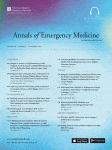Diagnostic Accuracy of High-Sensitivity Cardiac Troponin T at Presentation Combined With History and ECG for Ruling Out Major Adverse Cardiac Events

Study objective
We evaluate the diagnostic accuracy of a high-sensitivity cardiac troponin T (hs-cTnT) level less than 5 ng/L or less than or equal to 14 ng/L at emergency department (ED) presentation, combined with the emergency physician’s assessment of history and ECG, for ruling out major adverse cardiac events within 30 days.Methods
This prospective observational study enrolled consecutive ED chest pain patients. Emergency physicians’ assessments of patient history and ECG were collected. The primary outcome was 30-day major adverse cardiac events, defined as acute myocardial infarction, unstable angina, cardiogenic shock, ventricular arrhythmia, atrioventricular block, cardiac arrest, or death of cardiac or unknown cause.Results
A total of 1,138 patients were included in the final analysis. The combination of hs-cTnT less than 5 ng/L, a nonischemic ECG result, and a nonhigh risk history was present for 29.2% of all patients and had a sensitivity of 99.2% (95% confidence interval [CI] 95.6% to 100%), negative predictive value (NPV) of 99.7% (95% CI 98.3% to 100%), and a negative likelihood ratio of 0.02 (95% CI 0 to 0.17) for 30-day major adverse cardiac events. The same combination with hs-cTnT less than or equal to 14 ng/L was present in 66.7% of the patients and had a sensitivity of 92% (95% CI 85.8% to 96.1%), NPV of 98.7% (95% CI 97.6% to 99.4%), and negative likelihood ratio of 0.11 (95% CI 0.06 to 0.20).Conclusion
A single hs-cTnT result of less than 5 ng/L at ED presentation when combined with a nonischemic ECG result and a nonhigh risk history identified 29% of chest pain patients at a very low risk of 30-day major adverse cardiac events. A similar strategy with hs-cTnT less than or equal to 14 ng/L was associated with a higher miss rate.
Arash Mokhtari, Bertil Lindahl, Gustav J Smith, Martin J Holzmann, Ardavan Khoshnood, Ulf Ekelund
2016
Annals of Emergency Medicine, 68(6):649-658
